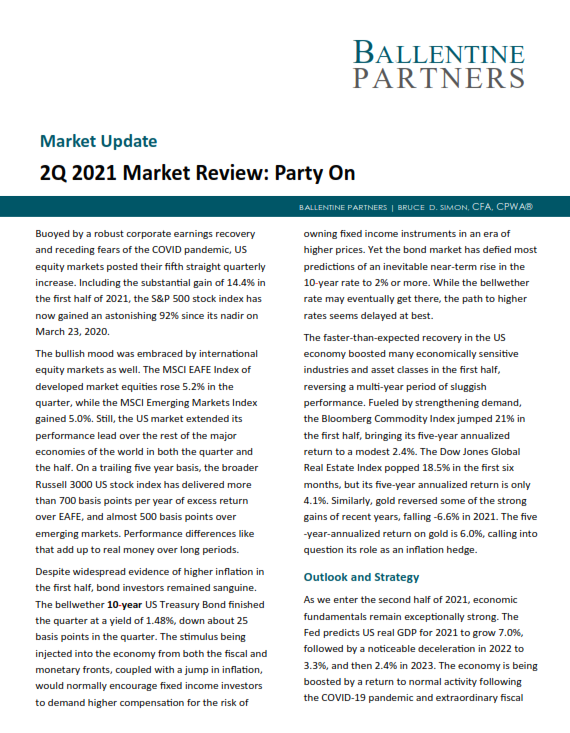Buoyed by a robust corporate earnings recovery and receding fears of the COVID pandemic, US equity markets posted their fifth straight quarterly increase. Including the substantial gain of 14.4% in the first half of 2021, the S&P 500 stock index has now gained an astonishing 92% since its nadir on March 23, 2020.
The bullish mood was embraced by international equity markets as well. The MSCI EAFE Index of developed market equities rose 5.2% in the quarter, while the MSCI Emerging Markets Index gained 5.0%. Still, the US market extended its performance lead over the rest of the major economies of the world in both the quarter and the half. On a trailing five year basis, the broader Russell 3000 US stock index has delivered more than 700 basis points per year of excess return over EAFE, and almost 500 basis points over emerging markets. Performance differences like that add up to real money over long periods.
Despite widespread evidence of higher inflation in the first half, bond investors remained sanguine. The bellwether 10–year US Treasury Bond finished the quarter at a yield of 1.48%, down about 25 basis points in the quarter. The stimulus being injected into the economy from both the fiscal and monetary fronts, coupled with a jump in inflation, would normally encourage fixed income investors to demand higher compensation for the risk of owning fixed income instruments in an era of higher prices. Yet the bond market has defied most predictions of an inevitable near-term rise in the 10-year rate to 2% or more. While the bellwether rate may eventually get there, the path to higher rates seems delayed at best.
The faster-than-expected recovery in the US economy boosted many economically sensitive industries and asset classes in the first half, reversing a multi-year period of sluggish performance. Fueled by strengthening demand, the Bloomberg Commodity Index jumped 21% in the first half, bringing its five-year annualized return to a modest 2.4%. The Dow Jones Global Real Estate Index popped 18.5% in the first six months, but its five-year annualized return is only 4.1%. Similarly, gold reversed some of the strong gains of recent years, falling -6.6% in 2021. The five-year-annualized return on gold is 6.0%, calling into question its role as an inflation hedge.
Outlook and Strategy
As we enter the second half of 2021, economic fundamentals remain exceptionally strong. The Fed predicts US real GDP for 2021 to grow 7.0%, followed by a noticeable deceleration in 2022 to 3.3%, and then 2.4% in 2023. The economy is being boosted by a return to normal activity following the COVID-19 pandemic and extraordinary fiscal and monetary support from the US government.
After peaking at an estimated 65% year-on-year growth in the second quarter, S&P 500 earnings are expected to rise by 36% in calendar 2021, followed by an 11% gain in 2022. The boom in corporate earnings has been one of the main drivers of the exceptional stock market performance over the last 14 months. In fact, while nervous investors fret over the high valuations in the stock market, the price/earnings ratio of the S&P 500 has actually declined over the past quarter as earnings have grown faster than prices.
The other important support for stock prices has been the exceptionally low levels of interest rates, which encourages businesses and consumers to borrow, and incentivizes investors to prefer stocks over bonds. Despite the consumer price index jumping by nearly 5% in May, one of the fastest increases in the last 30 years, interest rates have remained tame. (As of this writing, the yield on the 10-year treasury bond has fallen to nearly 1.30%, the lowest level since mid-February).
What accounts for fixed income investors’ sanguine attitude in the face of higher prices? If inflation averages 2% over the next 10 years, investors are locking in a negative real return, so that certainly can’t be the draw. We believe the demand for bonds at current rates is a combination of several factors: 1) evidence of a peaking in the rate on inflation in some areas that experienced sharp gains in recent months; 2) signaling by the Fed that they are willing to cut back their bond purchases and raise interest rates faster than previously expected, providing comfort to investors worried about a new inflationary spiral; and 3) purchases of US treasuries by non-US institutions, frustrated by the even lower rates in their home jurisdictions. Technically, the massive short position established by institutional investors expecting higher rates is being unwound, creating more demand for bonds and higher prices.
We believe the Fed’s gradual reduction of intervention in the bond market, coupled with ongoing economic strength, will reverse the recent rally in bonds and cause the 10-year treasury to approach a 2% yield by the end of the year. Such an outlook causes us to remain defensive on our bond positioning by holding duration below normal.
When considering the future path of equity prices, there is no shortage of risks to ponder. Valuations remain high, the Fed is calibrating a change to its easy money policy in order to choke off inflation, the Delta variant continues to create economic hardship for many countries around the world, and the Biden administration is lobbying for higher tax rates. Any of these events could spark a material change in investor enthusiasm for stocks.
Nonetheless, we believe underlying economic strength will continue to be an important support for equity prices in coming quarters. While the possibility of a near-term decline of up to 20% is always present (and by most measures overdue), nothing on the horizon would indicate that a more significant drop in equity markets is likely. Given the near doubling of the S&P 500 over the past 14 months, a meaningful decline would still leave investors far better off than they were a year ago. We remain constructive on the outlook for public equities.
In addition, we are finding attractive opportunities in selective private investments, such as private real estate, private credit, and other non-traditional income strategies run by experienced operators in their area of specialty. We continue to search for opportunities that will enhance investment returns consistent with each client’s appetite for risk.
About Bruce D. Simon, CFA, CPWA®
Bruce is a Partner and the Director of Research at the firm. In addition to working directly with a number of family clients, Bruce serves on Ballentine’s Investment Management Committee, which is responsible for the oversight of all of the investment activities for the firm.
This report is the confidential work product of Ballentine Partners. Unauthorized distribution of this material is strictly prohibited. The information in this report is deemed to be reliable but has not been independently verified. Some of the conclusions in this report are intended to be generalizations. The specific circumstances of an individual’s situation may require advice that is different from that reflected in this report. Furthermore, the advice reflected in this report is based on our opinion, and our opinion may change as new information becomes available. Nothing in this presentation should be construed as an offer to sell or a solicitation of an offer to buy any securities. You should read the prospectus or offering memo before making any investment. You are solely responsible for any decision to invest in a private offering. The investment recommendations contained in this document may not prove to be profitable, and the actual performance of any investment may not be as favorable as the expectations that are expressed in this document. There is no guarantee that the past performance of any investment will continue in the future.




